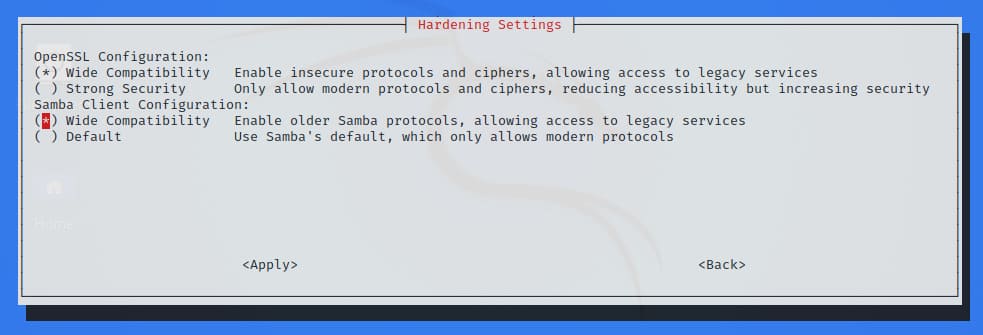Kali Linux 2021.4 was released today by Offensive Security and adds support for Apple M1, increased compatibility with Samba, added 9 new tools.
| Join the channel Telegram of the AnonyViet 👉 Link 👈 |

Kali Linux is a Linux distribution that allows security professionals and white hat hackers to perform penetration testing and security testing against network vulnerabilities.
With this release, the Kali Linux Team introduces a host of new features, including:
- Apple M1 Support for VMware Fusion Public Tech Preview
- Wide compatibility enabled for Samba
- Easier to switch to Cloudflare’s package manager
- Kaboxer updated, support for window and icon themes
- Updates for Xfce, GNOME and KDE
- Image Raspberry Pi Zero 2 W + USBArmory MkII ARM
- And 9 more tools
Support Apple M1
You can already install Kali Linux in Parallels on Apple Silicon Macs.
With Kali Linux 2021.4, you can now even install the distribution on VMware Fusion Public Tech Preview because the new kernel includes the necessary modules for virtual GPUs.
Using Kali’s installer will automatically detect if you are installing on VMware and check to install the appropriate packages.
Samba has wide compatibility
Since insecure protocols are detected in Samba, they are often disabled by default on Linux distributions for increased security.
Since Kali Linux is a penetration-testing distro, you’d better enable all protocols so that vandals can find older, vulnerable versions.
With this release, Offensive Security is configuring Samba for broad compatibility, which means they are enabling older Samba protocols.

9 new tools added to Kali Linux 2021.4
This wouldn’t be a new version of Kali Linux without some new tools and utilities, so this time Kali has added 9 new tools including:
- Dufflebag – Search for exposed EBS episodes
- Maryam – Open Source Framework (OSINT)
- Name-That-Hash – Find the hash structure
- Proxmark3 – if you are using Proxmark3 and hacking RFID
- Reverse Proxy Grapher – graphviz graph illustrating your reverse proxy flow
- S3Scanner – Scan open S3 buckets and dump content
- Spraykatz – Credential collection tool that automates procdump and remote parsing of the lsass process.
- truffleHog – Search through git repositories for strings and high entropy, dig into commit history
- Web of trust grapher (wotmate) – Find defunct PGP path without anything other than your own keyring
Advanced ARM Support
The Kali Linux team continues to improve support for ARM devices with the following changes:
- All images now use ext4 for filesystem root and change the size of hfilesystem root on the first boot. This will speed things up over previous releases that are using ext3 and reduce boot time on the first reboot when the resizing happens.
- Supports Raspberry Pi Zero 2 W, but like Raspberry Pi 400, there is no Nexmon support.
- Talking about the Raspberry Pi Zero 2 W, as it is very similar to the Zero W, the team also added the PiTail image to support the new processor with better performance.
- Image Raspberry Pi now supports booting via USB because the team no longer encrypts the original device.
- The Raspberry Pi image now includes the Nexmon firmware. A future release of kalipi-config will allow you to switch between them, if you want to test different versions.
- Images using the vendor’s kernel should now be able to set the specified domain properly.
- Pinebook Pro can now be overclocked. The large cores get 2GHz and the small cores get 1.5GHz.
echo 1 | sudo tee /sys/devices/system/cpu/cpufreq/boost to enable
echo 0 | sudo tee /sys/devices/system/cpu/cpufreq/boost to shutdown - Image USBArmory MkII has been added.
How to download Kali Linux 2021.4
To get started with Kali Linux 2021.4, you can either upgrade your existing installation or get an ISO image for new installs and live distributions. here.
For updates from the previous version, including the above settings Windows Subsystem for Linux (WSL)you can use the following commands to upgrade to the latest version.
echo "deb http://http.kali.org/kali kali-rolling main non-free contrib" | sudo tee /etc/apt/sources.list sudo apt update && sudo apt -y full-upgrade cp -i /etc/skel/.bashrc ~/ cp -i /etc/skel/.zshrc ~/ chsh -s /bin/zsh [ -f /var/run/reboot-required ] && sudo reboot -f
Once the upgrade is complete, you can see if the upgrade to Kali Linux 2021.4 was successful by using the following command:
grep VERSION /etc/os-releaseYou can find the complete change table for Potassium 2021.4 at Kali’s website.





